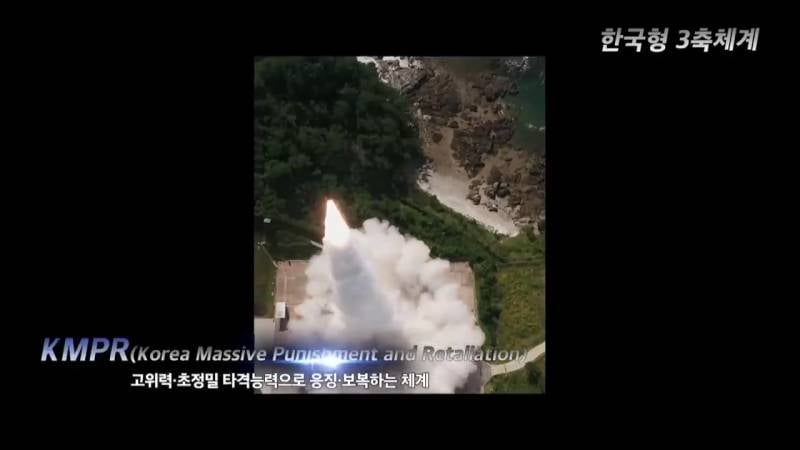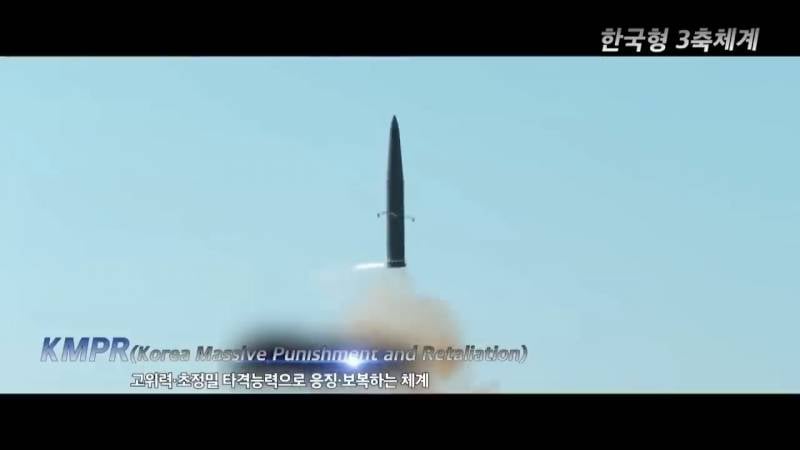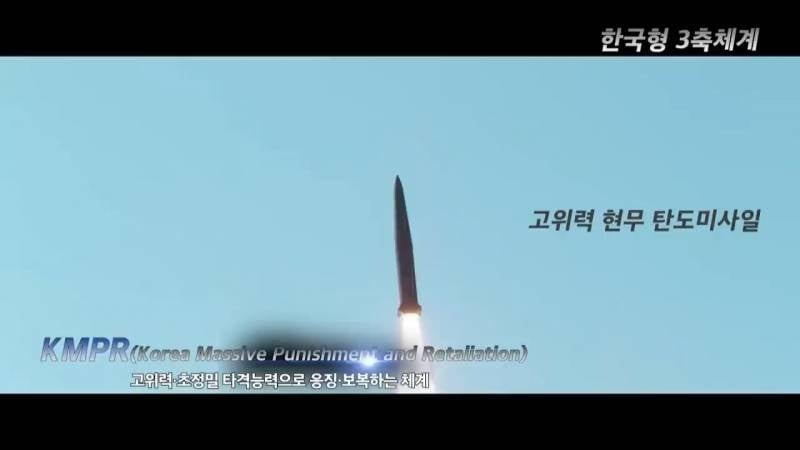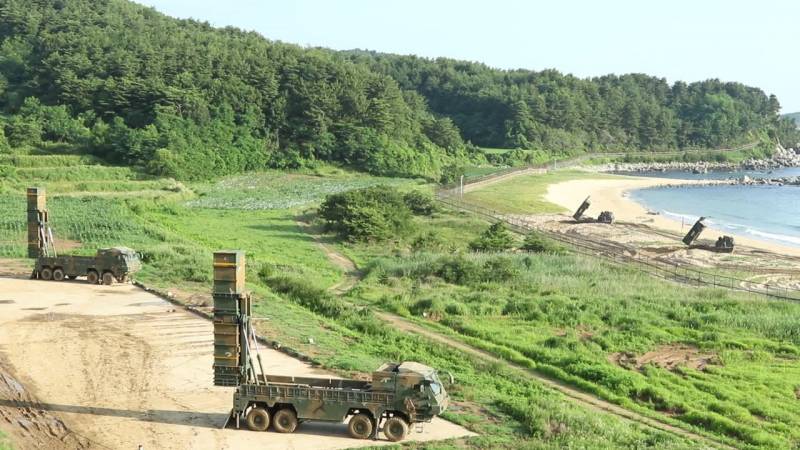New South Korean ballistic missile Hyunmoo 5

Rocket launch "Hyeonmu-5". Launcher obscured by smoke
In recent years, South Korea has paid increased attention to the development of advanced missile weapons. One of the latest and main results of such work has recently been the new Hyunmoo-5 rocket. It is reportedly the first South Korean medium-range ballistic missile. It is capable of flying at a distance of at least 3 km and carrying a large warhead.
Premiere in Moscow
On October 1, the Republic of Korea celebrated Armed Forces Day. By this date, the Ministry of Defense has prepared an interesting video showing the latest weapons of the army and its readiness to resist hypothetical aggression from the DPRK. In particular, the authors of the video paid great attention to the means and forces involved in the KMPR (Korea Massive Punishment & Retaliation) retaliatory strike plan.
Of greatest interest in this video are footage of the launch of a completely new ballistic missile. The first moments of the rocket flight are shown: it rises into the air due to the so-called. cold start, after which it turns on the main engine. In this case, the launcher does not fall into the frame, because. it is hidden by a cloud of smoke from the engine.
The new rocket is called Hyunmoo-5 (“Hyunmoo” - “Black Turtle”, a character in Chinese and Korean mythology associated with the constellations of the North) and belongs to the eponymous series of rocket weapons. The new rocket differs from the previous products of the line with increased characteristics. From the published data it follows that this is the first South Korean medium-range ballistic missile.
According to various sources, the flight range of the Hyonmu-5 IRBM can reach 3-3,5 thousand km. It is possible to use different combat units, incl. monoblock weighing 8-9 tons, however, in the latter case, the maximum range is reduced. It is assumed that such flight and combat characteristics will allow the new missile to attack targets throughout the territory of the DPRK and hit even complex objects.

Rocket releases restraints and fires propulsion engine
At the same time, most of the information about the new IRBM was not disclosed. For reasons of secrecy, the Ministry of Defense does not report the current status of the missile. Whether it was adopted or is still being tested is unknown. Even if such complexes are already on duty, their number, etc. are not specified. The same applies to the exact characteristics of the product.
Project without limits
The industry of South Korea has long been involved in the subject of ballistic and cruise missiles. However, until recently, the development of these areas faced serious political constraints. The United States effectively prohibited South Korea from developing long-range weapons with heavy warheads.
So, in 1979, a Korean-American agreement was signed, according to which Seoul could develop missiles with a range of no more than 180 km and warheads weighing up to 500 kg. In the future, the terms of this agreement were specified and softened. For example, in 2001 the permissible range was increased to 300 km. In 2012, conditions changed again. The maximum mass of the charge has increased to 2 tons, provided that the range of 300 km is maintained. It was also allowed to create missiles flying 800 km, but the warheads for them remained at the level of 500 kg.
In 2017, a new easing process began. Several important amendments were subsequently made to the agreements. Finally, in May 2021, the leadership of the United States and the Republic of Korea agreed to terminate all previous agreements and cancel any restrictions.
It should be noted that each time after the easing of restrictions, South Korea began to develop a new missile system with the highest possible characteristics at that time. As a result of these processes, the Hyonmu family of ballistic and cruise missiles appeared. The recent lifting of all restrictions has led to the emergence of another project, and a completely new class for the South Korean army.
According to known data
"Hyeonmu-5" is a land-based solid-propellant medium-range ballistic missile. It carries non-nuclear combat equipment and with its help should hit various enemy targets. The targets for it are command posts of the operational-strategic level, various bases, concentrations of troops, etc.

Flying with the engine running
The rocket is built according to a one- or two-stage scheme. It has a body with an elongated conical nose fairing and a cylindrical tail section. Stabilizers or rudders are placed in the tail. A significant part of the internal volumes is occupied by a solid fuel engine or engines. The length of the product is estimated at 15-16 m, diameter - 1,5-1,6 m. The starting weight can exceed 25-30 tons.
The launch is carried out from a ground launcher of an unknown type. Probably, as before in the Hyunmoo series, installation is used on a special multi-wheeled chassis or towed wheeled platform; the missile is in the transport and launch container. The MRBM leaves the TPK with the help of a powder charge, after which it turns on the main engine. Curiously, the mortar launch is used for the first time in the Hyeonmu series.
Apparently, a control system based on inertial and satellite navigation is used, which is standard for the IRBM. Accuracy parameters are unknown.
It is reported that there are several options for combat equipment. The missile can carry a monoblock warhead weighing up to 8-9 tons. A light warhead of 1 ton is also provided. According to foreign estimates, it is possible to use high-explosive fragmentation warheads with a penetrating effect. Thus, a large charge mass and high speed on the descending part of the trajectory will ensure the defeat of underground structures.
The flight range depends on the mass of the warhead. The minimum load can be sent to 3 thousand km or further. When using a heavy warhead, the range is limited to 300 km. Perhaps there is or will be developed some kind of "intermediate" warhead with a different combination of power and range.
Rocket and strategy
Thus, getting rid of restrictions, South Korea has developed its first medium-range ballistic missile. The American-Korean agreements became invalid only last year, and the development of a new weapons while there was little time. Therefore, it can be assumed that the Hyunmoo-5 complex is now at the stage of testing and preparation for production.

OTRK "Hyeonmu-2" (in the foreground) at a joint exercise, 2017
However, in the near future we should expect the completion of all necessary work and activities. After that, the first South Korean IRBM will go into service, and the required number of such products will be deployed in the troops. It should be expected that missiles with different warheads and flight characteristics will be put on combat duty, which will provide greater flexibility in use.
Not so long ago, Seoul adopted a new strategy for defense and countering the DPRK, based on the "three axes". The first "axis" is to create a reconnaissance and strike system for tracking a potential enemy. The second "axis" is called air defense and missile defense. The third is the retaliatory strike capability in the form of various weapons, designated as KMPR.
Thanks to its high performance and combat qualities, the new Hyunmoo-5 missile will become one of the foundations of the KMPR "axis". With the help of such weapons, the Republic of Korea will be able to keep the entire territory of the DPRK at gunpoint and will be able to attack any objects, incl. strategic value. At the same time, the new IRBMs will be supplemented with other missiles, ballistic and cruise, with other combat capabilities.
Arms race
The situation on the Korean peninsula remains difficult, and both republics are preparing for a possible armed conflict. For example, South Korea, having got rid of previously accepted obligations and restrictions, is trying to develop its missile systems and create new weapons with improved performance. The next achievement in this area is the product "Hyeonmu-5".
The first South Korean IRBM is considered as a response to the missile threat from the North. In turn, the DPRK considers the development of missiles in the South a preparation for aggression and is preparing retaliatory measures. In fact, we are talking about the continuation of the arms race. And now a new participant has appeared in it - a medium-range missile capable of influencing the general situation.
Information